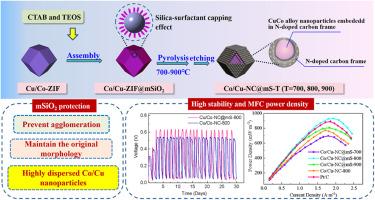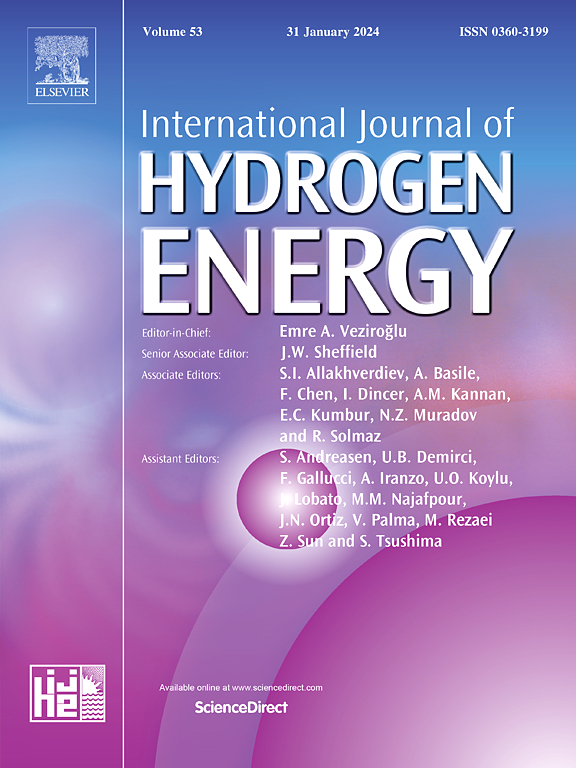Mesoporous silica-modified metal organic frameworks derived bimetallic electrocatalysts for oxygen reduction reaction in microbial fuel cells
IF 8.1
2区 工程技术
Q1 CHEMISTRY, PHYSICAL
引用次数: 0
Abstract
The design of cost-effective oxygen reduction reaction (ORR) catalysts in microbial fuel cells (MFCs) remains a challenge. Herein, a mesoporous silica (mSiO2) assisted protection strategy is developed to synthesize highly dispersed CuCo nanoalloys embedded in nitrogen doped carbon Cu/Co-NC@mS catalyst using zeolitic imidazolate framework (ZIF) as carbon and nitrogen sources. The results revealed that the mSiO2 protection holds the potential to inhabit CuCo nanoalloys from aggregation and thus promotes the formation of highly dispersed small CuCo nanoparticles. The obtained catalyst with pyrolysis temperature (T) of 800 °C (Cu/Co-NC@mS-800) achieves the best ORR performance among Cu/Co-NC@mS-T catalysts, yielding a maximum power density of 1000 mW m−2 when employed as air cathode MFCs. The significantly enhanced ORR performance of Cu/Co-NC@mS-800 could be attributed to following aspects: a) highly dispersed small CuCo nanoalloy particles, improved mesoporous surface area and volume owing to mSiO2 protection; (b) the formation of concave regular dodecahedron mesoporous structure with thin graphtic carbon layer as support; (c) the synergetic effect between CuCo nanoalloys. This work provides a facile strategy for the preparation of highly dispersed bimetal nanoalloys with enhanced electrocatalytic performance for energy-related applications.

介孔二氧化硅修饰金属有机骨架衍生的微生物燃料电池氧还原反应双金属电催化剂
在微生物燃料电池(MFCs)中设计高性价比的氧还原反应(ORR)催化剂仍然是一个挑战。本文采用介孔二氧化硅(mSiO2)辅助保护策略,以沸石咪唑酸骨架(ZIF)为碳氮源,在氮掺杂碳Cu/Co-NC@mS催化剂中包埋高分散CuCo纳米合金。结果表明,二氧化硅保护层有可能抑制CuCo纳米合金的聚集,从而促进CuCo纳米颗粒的形成。所得催化剂热解温度(T)为800℃(Cu/Co-NC@mS-800),在Cu/Co-NC@mS-T催化剂中ORR性能最好,用作空气阴极mfc时功率密度最大可达1000 mW m−2。Cu/Co-NC@mS-800的ORR性能显著提高主要得益于以下几个方面:1)CuCo纳米合金颗粒高度分散,mSiO2的保护提高了介孔表面积和体积;(b)形成以薄石墨碳层为支撑的凹形规则十二面体介孔结构;(c) CuCo纳米合金间的协同效应。这项工作为制备具有增强电催化性能的高分散双金属纳米合金提供了一种简便的策略,用于能源相关应用。
本文章由计算机程序翻译,如有差异,请以英文原文为准。
求助全文
约1分钟内获得全文
求助全文
来源期刊

International Journal of Hydrogen Energy
工程技术-环境科学
CiteScore
13.50
自引率
25.00%
发文量
3502
审稿时长
60 days
期刊介绍:
The objective of the International Journal of Hydrogen Energy is to facilitate the exchange of new ideas, technological advancements, and research findings in the field of Hydrogen Energy among scientists and engineers worldwide. This journal showcases original research, both analytical and experimental, covering various aspects of Hydrogen Energy. These include production, storage, transmission, utilization, enabling technologies, environmental impact, economic considerations, and global perspectives on hydrogen and its carriers such as NH3, CH4, alcohols, etc.
The utilization aspect encompasses various methods such as thermochemical (combustion), photochemical, electrochemical (fuel cells), and nuclear conversion of hydrogen, hydrogen isotopes, and hydrogen carriers into thermal, mechanical, and electrical energies. The applications of these energies can be found in transportation (including aerospace), industrial, commercial, and residential sectors.
文献相关原料
公司名称
产品信息
阿拉丁
Cobaltous nitrate hexahydrate (Co(NO3)2·6H2O)
阿拉丁
Copper(II) nitrate hydrate (Cu(NO3)2·3H2O)
阿拉丁
Hexadecyl trimethyl ammonium bromide (CTAB)
阿拉丁
Tetraacetyl orthosilicate (TEOS)
阿拉丁
2-methylimidazole
阿拉丁
Cobaltous nitrate hexahydrate (Co(NO3)2·6H2O)
阿拉丁
Copper(II) nitrate hydrate (Cu(NO3)2·3H2O)
阿拉丁
Hexadecyl trimethyl ammonium bromide (CTAB)
阿拉丁
Tetraacetyl orthosilicate (TEOS)
阿拉丁
2-methylimidazole
 求助内容:
求助内容: 应助结果提醒方式:
应助结果提醒方式:


